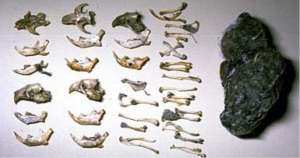Rodent Bones

CSI at the Zoo! What happened to these animal bones, thousands of years ago? A research team at Emory University is taking advantage of the fact that we feed our animals natural diets. In other words, for example, owls naturally consume rodents as prey, so we feed rodents to our milky eagle owls. Komodo dragons consume rodents and also tear flesh from the carcasses of larger prey, such as goats. The diet we offer to Rinca, the Komodo dragon at Zoo Atlanta, closely matches this. The bones of prey items that are pecked at, chewed upon, or passed through a predator’s digestive system often bear a physical record on their surfaces, which are called Bone Surface Modifications. Our colleagues at Emory University, Dr. Jessica Thompson and graduate student Grace Veatch, are studying the ancient ecosystems on the island of Flores, Indonesia, by examining the thousands of animal bones that have accumulated in a cave there known as Liang Bua. The Bone Surface Modifications on these accumulated bones—literally, the bite and claw marks and chemical scars from the digestive process—tell us a lot about who was eating whom, and how so. This site is especially interesting because the ecology of the island of Flores has been dramatically altered by human influence over thousands of years, including the introduction of non-native species such as goats and pigs. Flores, of course, is also the native home to the Komodo dragon which, prior to arrival of humans, was the top predator on the island. So, with the Zoo’s approval, to document clawing and chewing behaviors, the Emory team films a variety of relevant species at the Zoo while they eat their dinner, and then the keepers collect any bones that may be left over or passed through the digestive system a day or so later and send them over to the lab at Emory. Thus, Dr. Thompson’s lab is building a reference collection of representative animal bones so they can compare, for example, what a rat tooth looks like that has been eaten by an owl vs. by a Komodo dragon. What a fascinating and creative approach to their research on the relationship of humans and wildlife over millennia in Indonesia.
Read more about the research of Dr. Thompson and her colleagues here: https://scholarblogs.emory.edu/jcthompson/
Joe Mendelson, PhD
Director of Research

Connect With Your Wild Side #onlyzooatl